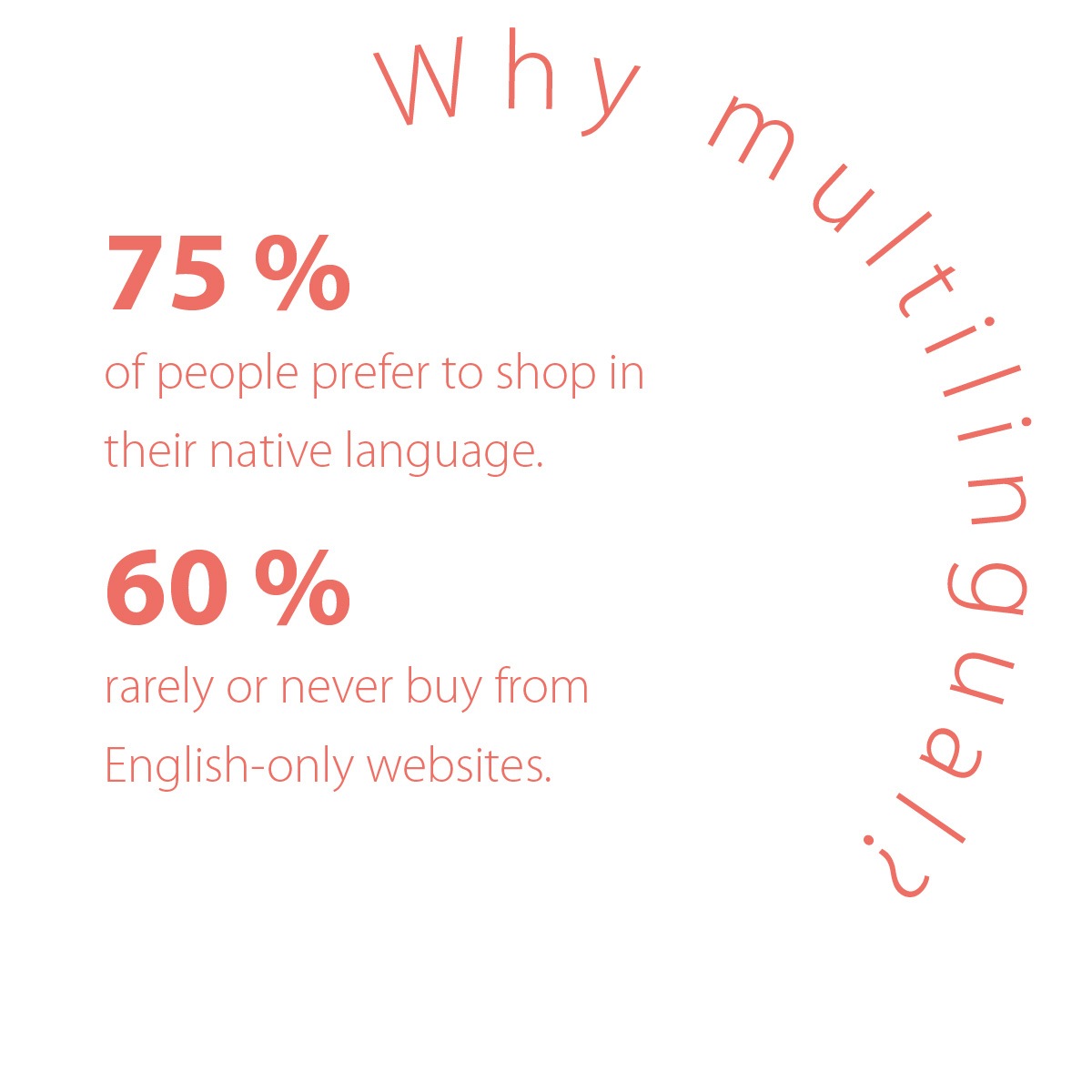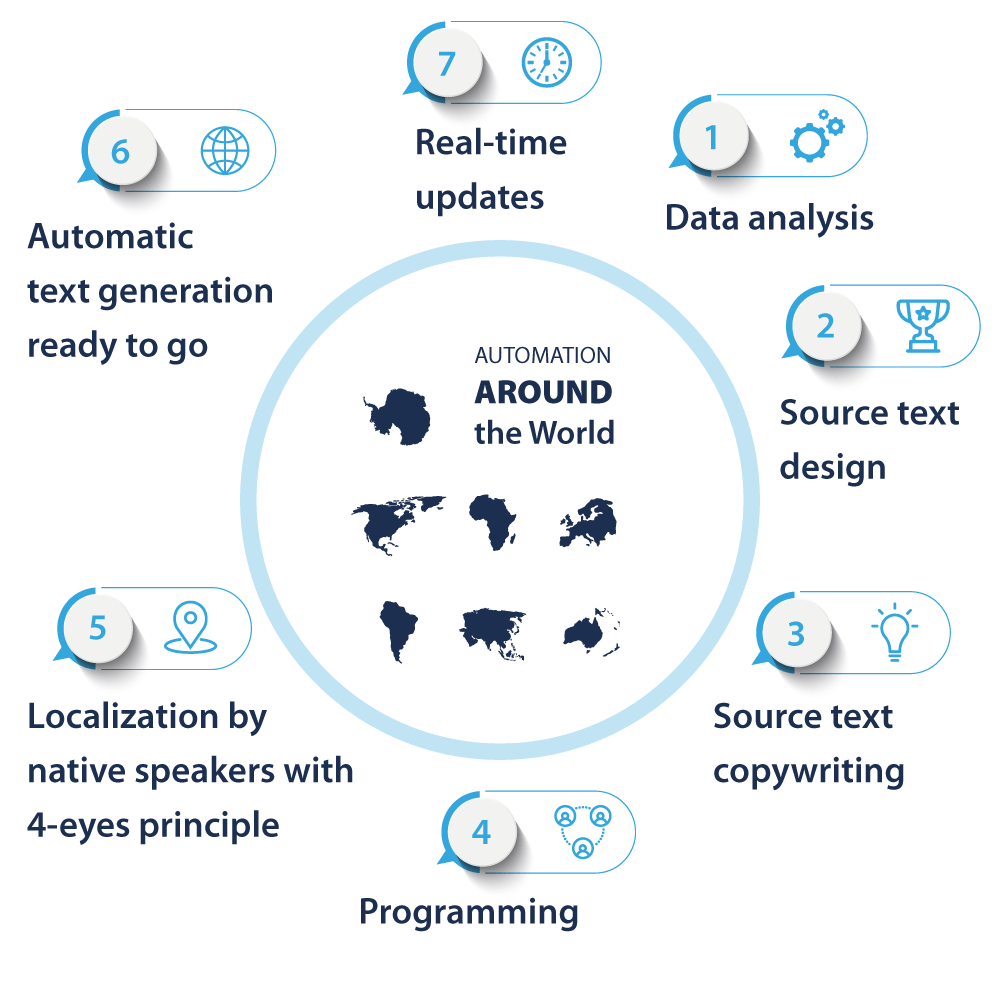High-Quality Automated Product Texts For International E-commerce
Written by
Editorial TeamPublished on

Filling your e-commerce store with high-quality product information can be time-consuming, especially if you have an extensive product portfolio – and even more so if you want to stand out in the international market.
The fact is that having a good understanding provides security. This also applies online – and to language. Many people do not feel fully comfortable using English, although they can understand it. And when it comes to legal matters or money, most people play it safe. Those who engage with their customers in their own language and culture are therefore able to build trust. A target group-orientated approach and user-friendliness are essential when it comes to e-shopping. Only the local expertise of native speakers in the target countries guarantees an authentic user experience and high conversion rates across language barriers.

Cf. “Can’t Read, Won’t Buy: 2014” (CSA Research, 2014)
The key to successfully entering an international market is therefore to create positive shopping experiences at every stage of the customer journey. In this case, manual copywriting and translation achieve the best results because copywriters and human translators use language that connects with the target group, establishes credibility and encourages people to make a purchase.
Having unique product descriptions is extremely important for your company: they not only help you to stand out from the competition, but also optimize your search engine ranking. When it comes to search engine ranking, ensuring the right length of the product text and the use of appropriate keywords, as well as taking into account different search habits and cultural preferences in each country all play a role.
The crux of the matter, however, is that a professional copywriter needs several months to create thousands of unique product descriptions. These then need to be translated into multiple languages, which is not a viable solution if your company wants to compete on a global scale and perhaps even sell seasonal items or fast fashion. The demands for maximum flexibility and speed in online retail therefore require innovative solutions.
Is AI the solution?
In the age of ChatGPT & Co., it makes sense that chatbots that use artificial intelligence and modern machine learning technology would be your first port of call to help you create natural-sounding content for your product descriptions in the blink of an eye.
The use of generative AI certainly has its benefits, but it is also worth acknowledging its challenges. The biggest challenge is to ensure that the texts generated meet the requirements of your company and your target group, not only in terms of quantity, but also quality. This requires identifying and correcting any misinformation.
Large Language Models (LLM), as used by AI, generate their output based on the probabilities of the next word – they do not check how true it is. This can lead to it “hallucinating”, i.e. generating output that is fictitious.
Content with AI – an issue of liability too
When using ChatGPT or similar AI text generators, it is important to note that the generated content is based on machine learning. It cannot be guaranteed that it is error-free and, most importantly, legally sound. The AI model provider may have stipulated certain disclaimers in the terms of use. It is advisable to read these carefully to understand the contingent liabilities.
Ultimately, as the content writer, you – or your company – are responsible for the automated content that is generated. Therefore, it is essential to check the texts carefully. This is the only way to ensure that they are accurate and comply with legal requirements. Particularly in a B2B context, where technical expertise is essential, it is even advisable to have the generated content checked for legal compliance with the relevant laws and regulations.
Post-prompting and human revision can still improve texts that are inadequate to meet the desired level of content. However, while this approach is still feasible for a manageable number of product descriptions, it becomes extremely time-consuming when there are thousands of them – and is anything but effective.
Large Language Models vs. Data-to-Text
Another challenge when it comes to AI-generated texts: ChatGPT can communicate in a number of languages, including German, English, Spanish, French, Chinese, Russian and many more. You can utilize this ability and save yourself the trouble of hiring a translator – but you won’t be able to judge the quality of the output if you don’t speak the language.
The good news is that large language models are not the only technology that can help you to automatically generate customized multilingual product texts. If you want to create high-quality, data-driven texts, there are automation technologies that create content based on your own product data – and thus significantly boost your efficiency.

The properties of the product are important components for automatic text generation.
How does this so-called data-to-text work? A software-as-a-service solution – such as the one from AX Semantics – analyzes your structured product data and allows you to set individual rules. These rules can include variations for individual words or entire sentences so that automated product texts can be generated in a wide range of variations at the click of a button. The finished texts can be integrated directly into your online store using the API interface.
Content at the push of a button? Yes! But unique, error-free and scalable
The more extensive the data basis, the more detailed and comprehensive your text concept can be. The quality of your data determines the quality of the texts that are generated from it. Even if the initial configuration of your project is quite time-consuming and takes a few weeks in the cases of large stores and many languages, this initial effort is worth it, as the software – once perfectly set up – repeatedly generates multilingual product descriptions with a simple click, without the need for further editing.
This approach allows you to repeatedly generate large volumes of text in multiple languages in a scalable manner. By using SEO-relevant product descriptions, your store is optimally supplied with texts, avoiding duplicate content and ensuring that it is easy to find online worldwide.
Best of all, the automated generation is based purely on your own product data without the involvement of external tools, so your data is completely secure. The automated content can also be generated in a number of variants, which further improves the scalability of your text model and therefore the ranking of your store.
Localized and automated – with 4-eye principle
To teach the text robot all the other languages you need for your international commerce, the next step is to translate your product data. Keep in mind that you want to build trust and credibility with your online store. Simply translating your content is not enough; it needs to be localized in order to perfectly adapt it to the language and culture of the target country.
Every language has its own unique nuances and cultural differences that only interculturally competent, native-speaking specialist translators can translate in a targeted manner. Localized translation is not just about the language itself, but also about differences in wording, purchasing behavior and search queries of the users in the target countries, for example. Professional linguists are also well versed in the specialist vocabulary commonly used in your industry. Especially in highly regulated industries such as medicine, the smallest inaccuracies can have serious consequences.
Your requirements regarding the text layout, tonality and corporate language can be easily integrated into the configuration in all desired languages. This ensures consistency in global communication for your brand. After the initial configuration, you can then let the smart algorithms do the work for you in the background and automatically create thousands of texts in whatever language you desire. When the text design is configured by language service provider Transline as a managed service provider of AX Semantics, the quality of the target language texts is reliably checked in accordance with 4-eye principle.

The 6 biggest challenges of global content creation and their solutions
Most online stores face the same challenges when it comes to global content creation:
- A lot of text, little time. Automated text generation produces high volumes in the shortest possible time which provides you with a major competitive edge.
- Successful ranking. SEO-relevant product descriptions including numerous text variants prevent duplicate content and improve the ranking worldwide.
- More conversions. Texts that are authentic and tailored to a specific target group optimize customer engagement and performance by offering varied content for all product categories and target markets.
- Customer experience. By working with native speakers, your corporate language is reproduced authentically in the target markets, therefore increasing customer loyalty and satisfaction.
- Regular updates. Thanks to the scalability of the text design, frequent updates can be implemented with minimal effort.
- High-quality text in all languages. As the text elements are programmed with the help of professional native speakers, the output is guaranteed to be of high linguistic quality.
Conclusion
Authentic, target group-oriented texts not only optimize your customer engagement and performance, but also ensure an improved customer experience. Working with native speakers ensures high-quality translations and a culturally authentic, recognizable presence in all target markets.
A text robot solution like the one provided by Transline and AX Semantics enables your company to effectively tap into international markets – with error-free content in all languages and smooth, scalable processes. The automatically generated content can be transferred directly to your target system via API and published there immediately. Even frequent updates due to changes in the product range are handled with ease via the interface. Learn more about this solution >
***


